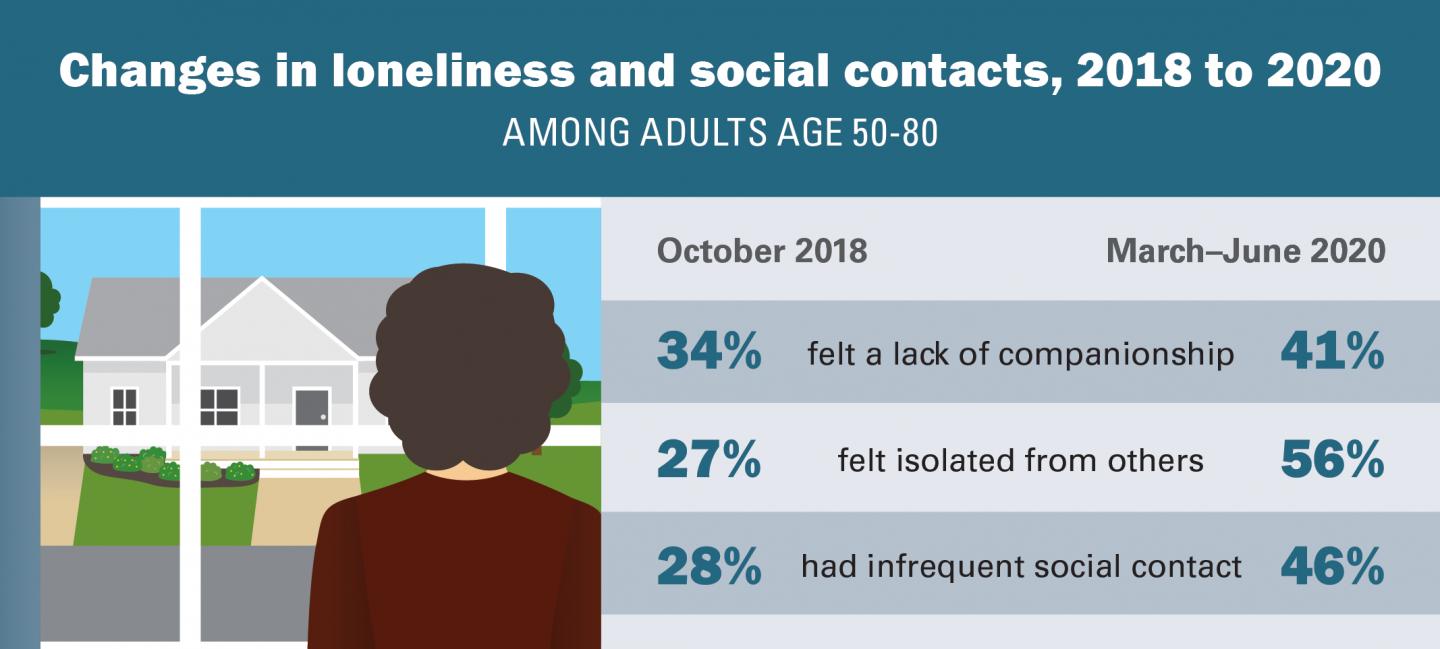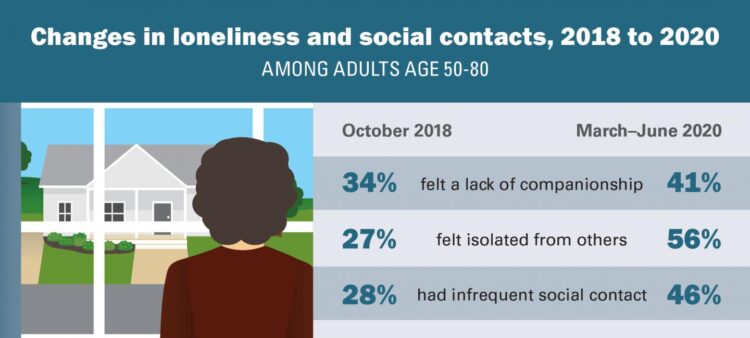Lack of social interaction or companionship is more common among those with health issues, but neighbors, healthy habits and technology may help

Credit: University of Michigan
Staying close to home and avoiding crowded places can help older adults reduce their risk of COVID-19. But a new national poll suggests it comes with a cost, especially for those with health challenges.
In June of this year, 56% of people over the age of 50 said they sometimes or often felt isolated from others – more than double the 27% who felt that way in a similar poll in 2018. Nearly half of those polled in June of this year also said they felt more isolated than they had just before the pandemic arrived in the United States, and a third said they felt they had less companionship than before.
Social contacts suffered too, with 46% of older adults reporting in June that they infrequently interacted with friends, neighbors or family outside their household – doing so once a week or less — compared with 28% who said this in 2018.
The new findings come from the National Poll on Healthy Aging, which is done for the University of Michigan’s Institute for Healthcare Policy and Innovation with support from AARP and Michigan Medicine, U-M’s academic medical center. Both the 2020 and 2018 polls on loneliness involved a national sample of more than 2,000 adults aged 50 to 80.
The poll points to some bright spots, too. For instance, the 46% of older adults who said they interacted with people in their neighborhood at least once a week were less likely to say they’d experienced forms of loneliness. Technology also helped many people over 50 connect with others, including the 59% who reported using social media at least once a week, and the 31% who used video chat at least once a week.
And many older adults said they engaged in healthy behaviors despite the pandemic — including 75% who said they were getting outdoors or interacting with nature, and 62% who said they got exercise several times a week. But those experiencing loneliness were less likely to engage in these healthy behaviors.
“As the pandemic continues, it will be critical to pay attention to how well we as a society support the social and emotional needs of older adults,” says John Piette, Ph.D., a professor at the U-M School of Public Health who worked with the poll team. “The intersection of loneliness and health still needs much study, but even as we gather new evidence, all of us can take time to reach out to older neighbors, friends and relatives in safe ways as they try to avoid the coronavirus.”
“The change we see in these measures in less than two years is truly remarkable,” says Preeti Malani, M.D., the U-M Medical School professor who directs the poll and has training in geriatrics and infectious diseases. “The use of technology to bridge the gap, and the importance of keeping up healthy routines like exercise, sleep, a balanced diet and getting outside, will no doubt continue to be important in the months ahead.”
Interactions with health and lifestyle
Malani notes that 80% of those polled in June said they were eating a healthy diet, and 81% said they got enough sleep – almost exactly the same as in the 2018 poll.
The poll also found that half of those who live alone, and just over half (52%) of those who are unemployed or disabled, said they felt a lack of companionship, compared with 39% of those who live with others, work or are retired.
Similarly, just over half of those who said their physical health was fair or poor, and two-thirds of those who said the same about their mental health, said they lacked compantionship. Nearly three-quarters of those who said their mental health was fair or poor said they felt isolated, compared with 55% of those reporting better mental health.
The use of technology to connect appears to be a double-edged sword, with those who use social media and video chat being more likely to say they felt isolated.
Moving forward
As the pandemic continues, and older adults try to avoid coronavirus infection and the outsize risk to their health, AARP is offering resources, including tips for older adults to avoid feeling isolated despite the pandemic. AARP Foundation’s Connect2Affect website includes a tool that can help older adults assess their level of isolation, and connect them to resources and opportunities in their area.
“Past studies have shown that prolonged isolation has a profound negative effect on health and wellbeing — as much as smoking 15 cigarettes a day,” says Alison Bryant, Ph.D., senior vice president of research for AARP. “It’s not surprising that older adults reported more loneliness since the pandemic began, particularly those who live alone. We need to continue finding ways to connect and engage with one another throughout this public health crisis.”
The National Academies of Sciences, Engineering and Medicine issued a report in February 2020 about the need for the health care system to help in preventing, identifying and addressing loneliness in people over 50.
The National Poll on Healthy Aging results are based on responses from a nationally representative sample of 2,074 adults aged 50 to 80 who answered a wide range of questions online. Questions were written, and data interpreted and compiled, by the IHPI team. Laptops and Internet access were provided to poll respondents who did not already have them.
###
A full report of the findings and methodology is available at http://www.
Media Contact
Kara Gavin
[email protected]





